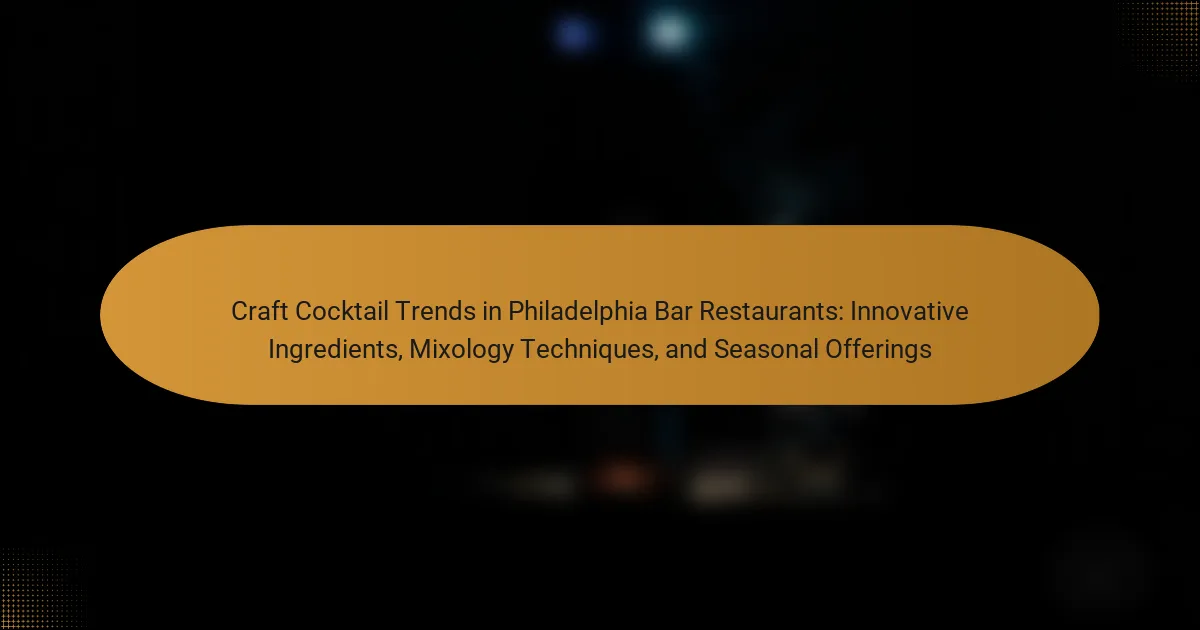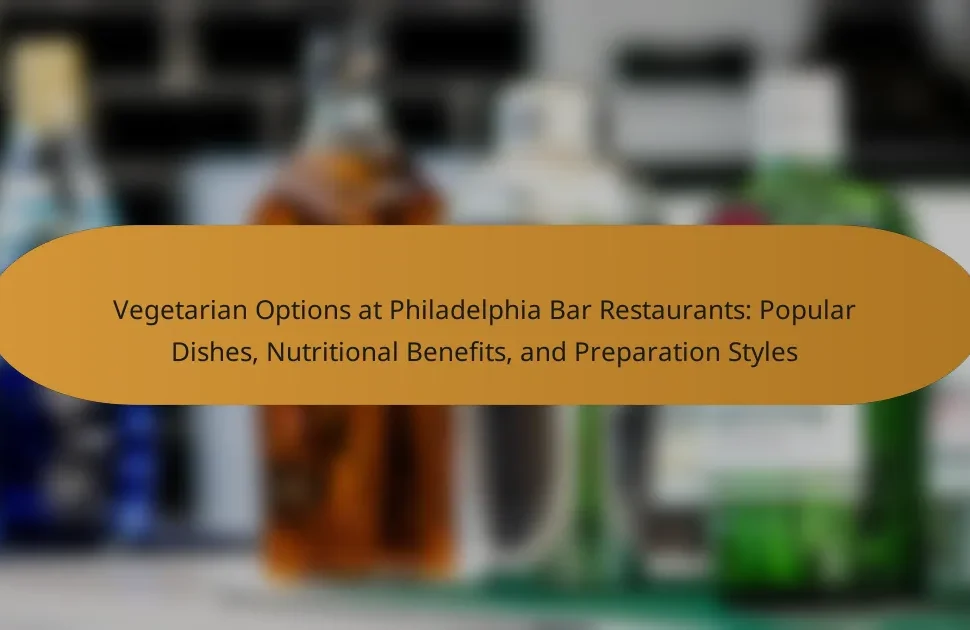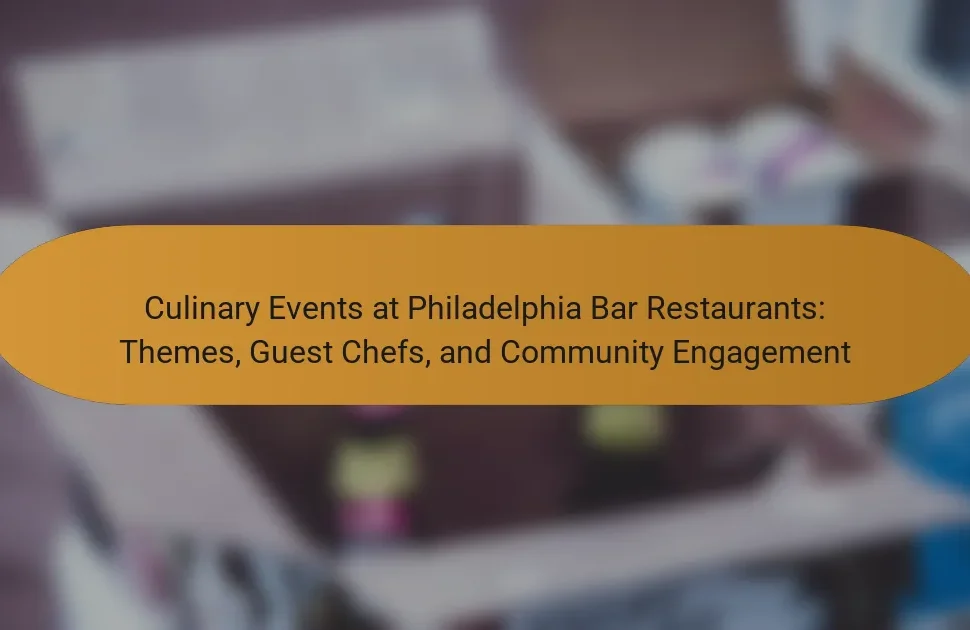
What are the current craft cocktail trends in Philadelphia bar restaurants?
Current craft cocktail trends in Philadelphia bar restaurants include the use of local ingredients and seasonal flavors. Many establishments focus on sustainability by sourcing spirits and mixers from nearby producers. Innovative mixology techniques, such as barrel-aging and smoking, are gaining popularity. Creative presentations, including unique glassware and garnishes, are also trending. Additionally, there is a rise in low-alcohol and non-alcoholic options to cater to diverse preferences. Cocktail menus frequently change to reflect seasonal ingredients and emerging flavor profiles. This approach enhances the dining experience and keeps offerings fresh.
How have innovative ingredients influenced these trends?
Innovative ingredients have significantly influenced craft cocktail trends in Philadelphia bar restaurants. These ingredients introduce unique flavors and enhance the overall drinking experience. For instance, the use of locally sourced herbs and fruits reflects a commitment to sustainability and freshness. This trend aligns with consumer preferences for artisanal and authentic experiences. Additionally, ingredients like infused spirits and exotic bitters create complex flavor profiles. Such innovations attract a diverse clientele seeking novel drinking options. According to a 2021 report by the Beverage Information Group, 60% of consumers are more likely to try cocktails featuring unusual ingredients. This statistic underscores the growing demand for creativity in mixology.
What unique ingredients are being used in Philadelphia’s craft cocktails?
Philadelphia’s craft cocktails often feature unique ingredients such as local honey, house-made syrups, and artisanal bitters. Local honey adds a distinct sweetness and regional flavor. House-made syrups incorporate seasonal fruits and herbs, enhancing freshness. Artisanal bitters provide complex flavor profiles, often infused with spices or botanicals. Additionally, ingredients like smoked spirits and unusual garnishes, such as edible flowers, are popular. These elements reflect Philadelphia’s emphasis on local sourcing and creativity in mixology. The use of such ingredients contributes to the city’s vibrant cocktail culture.
How do these ingredients enhance flavor profiles?
Ingredients enhance flavor profiles by introducing unique tastes and aromas. For example, herbs like basil provide freshness and complexity. Citrus fruits add brightness and acidity, balancing sweetness. Spices such as cardamom introduce warmth and depth. Ingredients like bitters contribute layers of flavor, enhancing overall complexity. Infused spirits can bring distinct characteristics from various botanicals. Seasonal fruits offer natural sweetness and vibrant color, appealing to the senses. Each ingredient works synergistically to create a harmonious and memorable drinking experience.
What mixology techniques are gaining popularity in Philadelphia?
Techniques such as sous-vide infusion, barrel aging, and fat-washing are gaining popularity in Philadelphia mixology. Sous-vide infusion allows bartenders to extract flavors from ingredients at controlled temperatures. This method enhances the depth of cocktails while maintaining clarity. Barrel aging gives drinks a complex flavor profile by maturing them in wooden barrels. This technique is often used for spirits and cocktails alike. Fat-washing incorporates fats into cocktails, adding richness and unique flavors. These innovative methods reflect a trend towards creativity and craftsmanship in the city’s cocktail scene.
Which techniques are considered innovative in the local cocktail scene?
Innovative techniques in the local cocktail scene include the use of molecular mixology, which incorporates scientific methods to create unique textures and flavors. Techniques such as sous-vide infusion allow bartenders to extract flavors more efficiently from ingredients. Smoke-infused cocktails are gaining popularity, utilizing smoking guns or wood chips for added depth. Additionally, the incorporation of local and seasonal ingredients showcases creativity and sustainability in mixology. Bartenders are also experimenting with fermentation to create unique flavor profiles in cocktails. These techniques reflect a shift towards artistry and innovation in cocktail preparation.
How do these techniques affect the overall cocktail experience?
Mixology techniques significantly enhance the overall cocktail experience. These techniques influence flavor balance, aroma, and presentation. For instance, techniques like muddling release essential oils from herbs and fruits, intensifying flavors. Shaking cocktails with ice chills and dilutes the drink, creating a smoother texture. Layering ingredients through precise pouring showcases visual appeal, enhancing the drinking experience. Additionally, techniques such as infusing spirits with unique flavors introduce innovative tastes. According to a 2022 study by the Journal of Culinary Science, cocktails made with advanced techniques received higher customer satisfaction ratings. This indicates that the implementation of these techniques positively impacts the overall enjoyment of cocktails.
What seasonal offerings are prominent in Philadelphia’s craft cocktail menus?
Seasonal offerings in Philadelphia’s craft cocktail menus prominently feature fresh, local ingredients. Spring menus often include floral elements like elderflower and herbs such as mint. Summer cocktails highlight fruits like watermelon and berries, providing refreshing flavors. Autumn sees the rise of spiced ingredients, including apple cider and cinnamon. Winter cocktails frequently incorporate warming spices and citrus, like ginger and blood orange. These seasonal ingredients reflect the region’s agricultural bounty and enhance the cocktail experience. Many bars craft unique drinks to celebrate these seasonal changes, attracting patrons looking for fresh and innovative flavors.
How do seasonal ingredients impact cocktail creation?
Seasonal ingredients significantly enhance cocktail creation by introducing fresh flavors and aromas. These ingredients reflect the local harvest, making cocktails more vibrant and relevant to the time of year. For instance, summer cocktails often feature fruits like watermelon and peaches, while fall drinks may incorporate spices like cinnamon and apple. Utilizing seasonal ingredients can also promote sustainability by reducing carbon footprints associated with transportation. Furthermore, seasonal offerings can attract customers seeking new experiences, as they align with trends toward local and fresh dining. Research indicates that bars using seasonal ingredients often see increased customer satisfaction and repeat business.
What are some examples of seasonal cocktails currently featured?
Seasonal cocktails currently featured include the Spiced Apple Cider Mule, Pumpkin Spice Martini, and Cranberry Sage Spritz. The Spiced Apple Cider Mule combines vodka, apple cider, and ginger beer. It is garnished with cinnamon and apple slices. The Pumpkin Spice Martini blends vodka, pumpkin puree, and cream. It is topped with a sprinkle of nutmeg. The Cranberry Sage Spritz features gin, cranberry juice, and sage syrup. It is served with club soda and fresh sage leaves. These cocktails reflect seasonal flavors and ingredients.

How do Philadelphia’s craft cocktail trends compare to other cities?
Philadelphia’s craft cocktail trends are characterized by a strong emphasis on local ingredients and innovative techniques. This sets them apart from cities like New York and San Francisco, where the focus may lean more towards international influences and classic recipes. In Philadelphia, bartenders often highlight regional spirits and seasonal produce. For example, many establishments incorporate locally distilled spirits from Pennsylvania distilleries.
Additionally, Philadelphia’s cocktail scene is known for its creativity in flavor combinations. Unique ingredients such as house-made bitters and infused syrups are commonly used. This trend mirrors movements in other cities but with a distinct local twist.
Furthermore, the city’s cocktail culture is increasingly collaborative. Many bars participate in events that showcase local talent and products. This community-driven approach fosters a unique atmosphere compared to other urban cocktail scenes. Overall, while Philadelphia shares similarities with other cities, its focus on locality and innovation defines its craft cocktail trends.
What sets Philadelphia apart in its craft cocktail culture?
Philadelphia’s craft cocktail culture is distinguished by its emphasis on local ingredients and innovative mixology techniques. Many bars source produce, spirits, and herbs from nearby farms and distilleries. This focus on local sourcing enhances the freshness and quality of cocktails. Additionally, Philadelphia’s cocktail scene embraces seasonal offerings, changing menus to reflect the time of year. This adaptability allows bartenders to create unique drinks that resonate with local flavors. The city’s rich history and diverse cultural influences also inspire creative cocktail recipes. Many establishments incorporate traditional recipes with modern twists, showcasing Philadelphia’s unique identity in the craft cocktail landscape.
How does the local palate influence cocktail development?
The local palate significantly influences cocktail development by dictating flavor preferences and ingredient choices. Regional tastes shape the types of spirits, mixers, and garnishes used in cocktails. For example, Philadelphia’s culinary scene emphasizes fresh, local ingredients. This trend leads bartenders to incorporate seasonal fruits and herbs into their cocktails. Additionally, the popularity of craft beer in Philadelphia inspires unique beer cocktails. Local cultural influences also play a role in flavor profiles, reflecting the city’s diverse heritage. This results in innovative combinations that resonate with local consumers. Ultimately, understanding the local palate is essential for creating cocktails that appeal to the community.
What are the key differences in ingredient sourcing between cities?
Ingredient sourcing varies significantly between cities due to local agricultural practices, climate, and market access. Cities with nearby farms, like Philadelphia, benefit from fresh, seasonal produce. This proximity allows bars to source ingredients like herbs and fruits directly from local growers. In contrast, urban areas without nearby agriculture may rely on imported goods. This can lead to higher costs and less freshness in cocktails. Additionally, cultural preferences influence sourcing. Cities with diverse populations may prioritize unique, ethnic ingredients. For example, Los Angeles may emphasize tropical fruits, while New York might focus on artisanal spirits. These differences shape the cocktail offerings in each city, reflecting local tastes and availability.

What challenges do Philadelphia bar restaurants face with craft cocktail trends?
Philadelphia bar restaurants face several challenges with craft cocktail trends. High ingredient costs strain profitability for many establishments. Sourcing unique, quality ingredients can be difficult due to supply chain issues. Staff training for advanced mixology techniques requires time and financial investment. Competition among bars intensifies as more establishments adopt craft cocktail menus. Consumer expectations for innovative and seasonal offerings increase pressure on bar restaurants. Additionally, maintaining consistency in drink quality can be challenging with complex recipes. Compliance with local regulations regarding alcohol service adds another layer of difficulty for bar operators.
How do cost and availability of ingredients impact cocktail innovation?
Cost and availability of ingredients significantly influence cocktail innovation. High ingredient costs can limit experimentation with premium or exotic components. Bartenders may opt for more affordable alternatives to maintain profitability. Limited availability can restrict access to unique flavors or seasonal ingredients. This may lead to creative substitutions or adaptations of classic recipes. For example, a shortage of fresh herbs might prompt the use of infused syrups instead. Innovation often arises from necessity, driving mixologists to explore local and sustainable options. In Philadelphia, this trend is evident as bars focus on regional ingredients. Such adaptations can enhance the local cocktail culture while responding to economic factors.
What strategies are bar restaurants using to overcome these challenges?
Bar restaurants are employing various strategies to overcome challenges in the craft cocktail industry. They are focusing on sourcing local and seasonal ingredients to enhance flavor and appeal. This approach not only supports local farmers but also creates unique drink offerings. Additionally, bar restaurants are investing in staff training to improve mixology skills. Skilled bartenders can craft innovative cocktails that attract customers.
Furthermore, they are leveraging social media marketing to engage with patrons and promote new menu items. This increases visibility and drives foot traffic. Some establishments are also implementing flexible pricing strategies to accommodate changing consumer spending habits. Offering happy hours or special promotions can attract a wider audience.
Finally, many bar restaurants are enhancing the overall customer experience by creating inviting atmospheres. This includes comfortable seating and engaging decor, which encourages patrons to linger longer. These strategies collectively help bar restaurants navigate the competitive landscape effectively.
How do economic factors influence cocktail pricing and offerings?
Economic factors significantly influence cocktail pricing and offerings. The cost of ingredients impacts the final price of cocktails. For example, when the price of premium spirits rises, bars may increase cocktail prices to maintain profit margins. Additionally, economic conditions affect consumer spending behavior. During economic downturns, consumers may prefer lower-priced cocktails or special promotions. Competition among local bars also plays a role in pricing strategies. Establishments may adjust their offerings based on what competitors charge for similar cocktails. Seasonal availability of ingredients can influence both pricing and cocktail variety. When certain fruits or herbs are in season, bars may feature them prominently, often at lower prices. Overall, economic factors create a dynamic environment that shapes cocktail pricing and offerings.
What are some best practices for creating innovative craft cocktails?
To create innovative craft cocktails, utilize fresh, high-quality ingredients. Incorporate unique flavor combinations that surprise the palate. Experiment with different textures using foams or purees. Use seasonal ingredients to enhance freshness and relevance. Implement advanced techniques like infusions or barrel-aging for complexity. Balance flavors carefully to ensure harmony in each drink. Presentation matters; use creative garnishes and glassware. Stay informed about current trends to inspire new ideas.
How can bar restaurants effectively source unique ingredients?
Bar restaurants can effectively source unique ingredients by establishing strong relationships with local farmers and suppliers. This approach ensures access to fresh, seasonal produce. Collaborating with specialty food distributors can also provide unique items not available in standard markets. Participating in local farmers’ markets allows bar restaurants to discover and negotiate directly with producers. Networking within the culinary community can lead to sourcing rare ingredients through chef recommendations. Additionally, utilizing online platforms that connect restaurants with artisanal producers can expand ingredient options. Research shows that sourcing locally can enhance menu appeal and support the local economy.
What tips can mixologists follow to enhance their cocktail techniques?
Mixologists can enhance their cocktail techniques by practicing precision in measurements. Accurate pouring ensures consistent flavor profiles. They should also experiment with fresh ingredients to elevate taste. Seasonal fruits and herbs can add unique flavors. Utilizing proper glassware enhances presentation and experience. Learning advanced techniques, such as molecular mixology, can create innovative drinks. Regularly tasting and adjusting recipes improves overall quality. Finally, studying classic cocktails provides a strong foundation for creativity.
Craft cocktail trends in Philadelphia bar restaurants highlight the use of local ingredients, innovative mixology techniques, and seasonal offerings. Establishments focus on sustainability, sourcing spirits and mixers from nearby producers while incorporating unique ingredients like local honey and house-made syrups. Popular mixology techniques include sous-vide infusion and barrel aging, enhancing flavor profiles and presentation. Seasonal menus reflect the region’s agricultural bounty, showcasing cocktails that resonate with local tastes. This article explores how these trends compare to other cities and the challenges faced by Philadelphia’s bar restaurants in maintaining innovation and quality.




